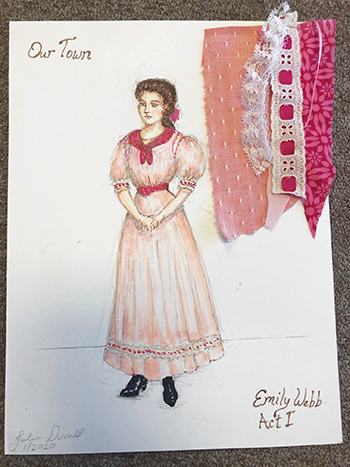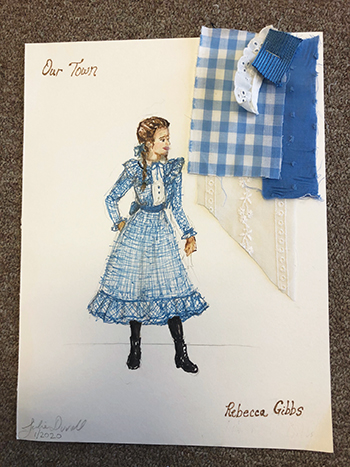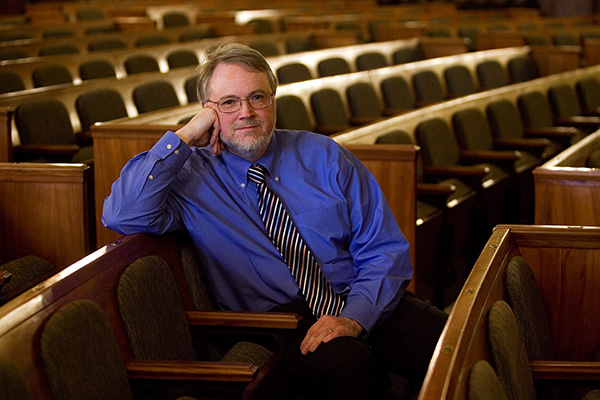
Q: Were there any activities you did as a child that led to your passion for the arts?
I can’t remember a time when I wasn’t doing something artistic or creative. I’ve always liked doing arts and crafts in school or at home. I spent hours drawing my own version of anime. I loved to dance, sing and listen to music. I played clarinet and saxophone in middle school and high school. An introduction to theatre class in college turned me on to theatre, which tied all my interests together.
Q: Where did you receive training?
I earned a bachelor of arts degree at the University of South Florida in Theatre Design and Technology. I studied set, costume, and lighting design. I earned my Masters in Fine Arts degree at the University of Missouri, Kansas City in Costume Design and Technology.
Q: What other companies have you most recently designed for?
Most recently, I worked with Pure Theatre on an interactive production of Oscelola’s Muse. I took a break from theatre design to raise my two daughters, Ava (13) and Anna (11). Before, I was the head of the Costume Design Program at the College of Charleston for five years.


Q: Please discuss your process as the Costume Designer for Our Town.
First, I read the script to get a general feel of what the play is about and how it made me feel. Then, I analyzed the script for all costume information. I noted the year it took place (1901, 1904, 1913), the setting (Grover Corners, New Hampshire), the time of year (spring and summer), the time of day, the weather, the occasion, and the style the show was written (minimalistic, theatrical–set on a stage). I then studied what is said about each character by other characters, what a character says about (him/her)self, and what is noted in the stage directions. I looked at the occupation, age, gender, lifestyle, and class of each character. I also tracked characters entrances and exits to plan out costume changes (stage managers provided some of this information). Once this was done, I met with the director, Marybeth Clark, and the design team and, together, came up with a concept or approach on how the overall production would look. We decided to keep the production in the era it was set, and keep the Stage Manager character in the same era as the play. We talked about how the costumes were to be the focal point of the show because of the sparse scenic elements. We chose to minimize the number of costumes for each character in order to keep with the abstract nature of the set design and echo the hazy nature of memory. I tried to keep characters in simple, unpretentious clothing of the middle class, but visually stimulating for the audience. Marybeth wanted a color pallet based on a drop Julian Wiles designed for the show. The colors are bright, saturated, and lively, which reflects the joys and simple beauty of daily life. This led me to choose costumes that were a bit more colorful than was usual back in the Edwardian period (tan, navy, & black). In contrast, Act III is in somber black for the funeral. I researched 1901-1913 fashion, life, and professions in books and on-line—Pinterest was my favorite source. Finally, I pulled as many costumes I could from Charleston Stage’s costume stock. I redesigned most of the women’s gowns to give them the line and details common in early 1900’s. We ordered corsets to help maintain the proper silhouette and physical movement of the era. I designed a few original pieces: Emily’s first act look, Rebecca’s “gingham dress,” and Mrs. Webb’s ensemble.


Q: What are you most excited about that audiences will experience with your designs for Our Town?
I hope some of the trimming details will be fun to see, but I hope nothing stands out as a distraction. I aim to always serve the play and it’s own idea of “truth.”
Q: Tell us a little more about yourself.
I absolutely love spending quality time with my wonderful and talented husband, Frank Duvall and our two daughters, Ava and Anna. When I’m not designing costumes, I teach. I taught sewing, rendering, pattern drafting, and fashion history at the Art Institute of Charleston for five years, before it closed. Now, I substitute for mainly middle school and high school classes on James Island. I like to paint, knit, shop, read and sew quilts in my free time. I also try to find time to take long walks at James Island County Park.
Performances of Our Town run February 5 – 23 at the Historic Dock Street Theatre. For tickets, click here.

